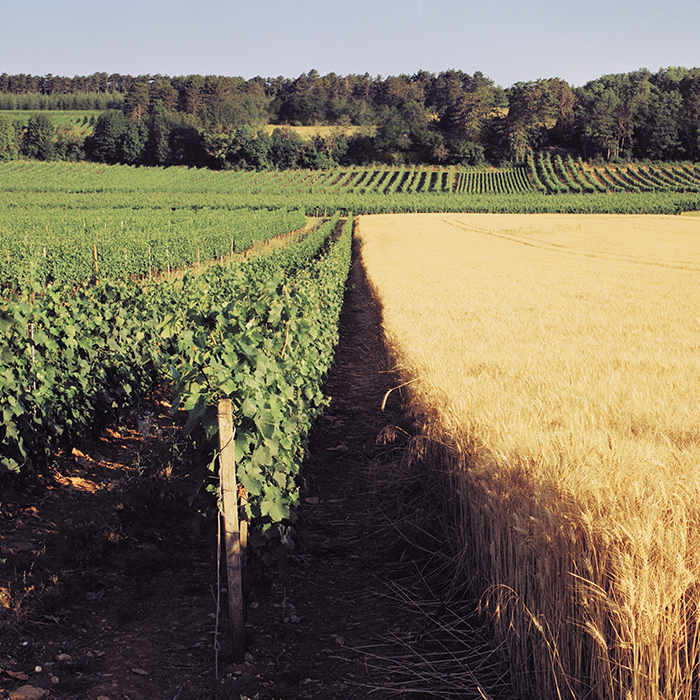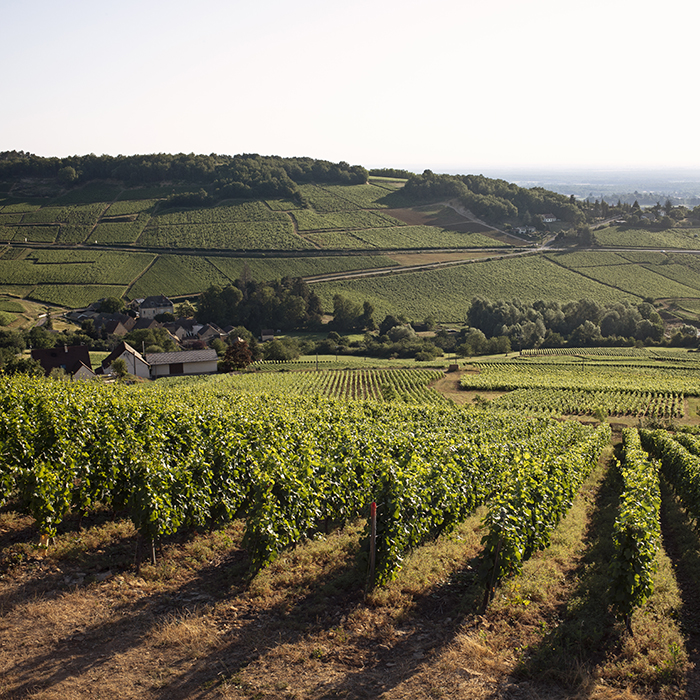Burgundy 2018: vintage report
Author: Adam Bruntlett

Update: Adam’s Burgundy 2019 vintage report is now available.
This is one of the rare vintages that offers both quality and quantity. On the face of it, 2018 was relatively straightforward; a wet winter and spring topped up the water reserves and the warm, sunny summer ensured the grapes reached ripeness without difficulty. The usual threats of disease, rot, frost and hail barely featured, and harvest took place under blue skies in 30-degree heat. However, the exceptionally warm and dry conditions posed a new challenge for vignerons, with the need to pick early enough to preserve grapes’ acidity, rather than the more familiar wait for ripeness to arrive. In the cellar, handling warm fruit with higher levels of sugar and lower acidity was another test for the region’s winemakers. It is therefore arguably both une année de vigneron as well as une année de vinificateur.
Winter and spring were unusually wet, with rainfall in January and March over twice the average for the time of year. This huge volume of rain – over 120mm in each of the two months – topped up the water reserves in the soil and would prove to be key for the forthcoming growing season. January was exceptionally mild, the warmest since 1945, and nervous vignerons began to worry that the vines would not have a period of cold weather to rest and allow the sap to descend. Fortunately, winter proper arrived in February, with average temperatures barely hovering above freezing. This welcome cold snap was followed by a more typical March and then another bizarre month in April, with temperatures of 30°C pushing the vines’ development rapidly. Once again, there was concern about the possibility of frost damage, but thankfully this was not a significant factor in 2018.
Through the rest of the spring and summer, temperatures were consistently at least 1.5 to 2 degrees above the average, while rainfall was a more mixed picture; the Côte d’Or experienced almost tropical conditions in May, with warm temperatures and daily rain showers combining to bring about significant mildew pressure, whereas Chablis and the Mâconnais were somewhat drier. August was universally dry and warm but without the heat spikes of 2003 or 2019, and consequently the vines did not shut down due to stress and there were no sunburnt grapes. Regular small showers kept the vines going, as well as the reserves accumulated earlier in the year.
There were two hailstorms in the southern part of Nuits-St Georges, Prémeaux-Prissey and the villages of Comblanchien and Corgoloin in July, the first on the 3rd and the second on the 15th, remembered because it was the day of France’s Football World Cup victory. The damage was substantial, with some small landslides and the loss of a proportion of the crop. Frédéric Mugnier lost around a half to a third of the fruit in the Clos de la Maréchale, while Patrice Rion’s vines in Clos St Marc and Clos des Argillières fared a little better. The saving grace was that the successful flowering and fruit set had meant that there was already a good crop on the vines, so in some ways this acted as a green harvest. Furthermore, the subsequent warm and dry weather allowed the damaged fruit to dry and fall easily from the vibrating sorting tables now used by the vast majority of growers.
The rest of the summer was dry and warm, with only sporadic rainfall. In Meursault, Jean-Baptiste Bouzereau reported that regular small showers of 20mm or so helped the vines to keep going, while in Puligny his records showed much drier conditions. Arnaud Ente was the first to begin picking in the Côte de Beaune on 20th August, with the majority picking the Chardonnay crop in the Côte d’Or from the 27th. The earliest red grapes picked among our growers were some of Domaine de la Vougeraie’s young vines of Volnay on 23rd August, and Louis Boillot, also in Volnay on the 25th.
In the Côte de Nuits the picture was a little less uniform. First out of the blocks was Domaine des Lambrays who began on the 27th of August. There was something of a split between those who went earlier and those who decided to wait, but it depended very much on location and the local weather conditions. Some growers such as Frédérique Sérafin felt that it was not possible to wait for full phenolic ripeness in Gevrey-Chambertin, so picked fairly early – in her case from 3rd September – to preserve freshness in the wines.
Others, such as Etienne Grivot in Vosne-Romanée, waited for the rain which duly arrived in the form of a downpour on 6th September, and picked from the 11th to 19th. Interestingly 20 to 25mm fell on the Côte de Beaune and the southern part of the Côte de Nuits, pushing north as far as the northern end of the Clos de Vougeot and stopping just before Chambolle. It is for this reason that grapes from Vosne and Nuits could be picked later without sacrificing freshness – as evidenced by Grivot and Guyon – but anything picked after the first week of September in Chambolle, Gevrey or Morey risked excessive alcohol as the sugar levels climbed rapidly, often gaining a degree of potential alcohol in just a few days.
The choice of picking date was therefore essential, but as ever it is impossible to draw direct comparisons between one estate and another, even in the same village and vineyard, because so many factors come into play in terms of the way each grower works their vines, which can change the ripening date by a week or more. Age of vine, exposition, soil type, rootstock, pruning method, the number of bunches on the vine, the treatments used, canopy management and various other factors all influence when fruit reaches ripeness, which in itself is a hard-to-define concept. What appears ripe for one grower may well be lean and flavourless for another, or equally overripe and good for only making jam.

The challenges didn’t end with choosing a picking date; harvesting in warm weather meant that fruit was often warm – and skins therefore fragile – when it arrived at the winery. Having done a stint on the sorting table in 2018 I can attest to the difference between warm and cool grapes, with the former often turning to pulp when handled. To combat this, many growers such as Benjamin Leroux have begun renting refrigerated containers to chill down any fruit picked later in the day, sorting and processing it once it is cooled down. In Chablis and the Côte Chalonnaise, where machine harvesters are more prevalent, growers could get out early in the morning before sunrise and pick grapes when they were cool.
Temperature control in the winery itself was key to avoiding stuck fermentations and consequent bacterial spoilage and oxidation, which were a real risk with relatively high levels of sugar in the grapes. Those who are not equipped with the facilities to control the temperature in the winery and their tanks, and who picked late and ended up with grapes around 15 degrees potential alcohol faced a huge struggle to produce clean, balanced wines. Fortunately, they were few and far between in our tastings, but wines have been rejected from our offer because of problems with Brettanomyces and volatile acidity.
Once again the question of whole-bunch reared its head. Those who practise it every year, for example Dujac, Domaine Guyon, de Montille and Domaine de la Vougeraie, used a large proportion (or even 100%) of whole clusters and have had great success. Others who de-stem as a matter of course remain steadfast in their approach. Some others chose to use more than normal, arguing that the stems add a feeling of freshness and dryness that counters the richness of the vintage. Others decided to reduce the percentage of whole-bunch, explaining that it deacidifies the wine and pushes the pH to a level that runs the risk of bacterial spoilage. As ever, the subject remains a polemic but success has been achieved with both approaches.
The result of this complicated year is what was described by many growers as a “heterogenous” vintage in terms of quality. Arguably the white wines are more consistent in quality than the reds, where there is much more variation according to when the grapes were picked. It is undeniable, however, that the red wines reach higher peaks and are the stars of the vintage. This variability and the importance of the grower means it is difficult to make generalisations about which areas had greater success. However, from my five weeks of barrel tasting during the autumn, a number of themes became clear:
- Generally speaking, cooler microclimates have done well. St Aubin whites are particularly impressive, as are the wines of the Hautes Côtes, Pernand-Vergelesses and St Romain.
- For reds, villages where tannins were historically somewhat rustic have overperformed, the warm vintage rounding out some of the sharp edges. Nuits-St Georges, Aloxe-Corton and Pommard, as well as Chassagne-Montrachet, Maranges and Santenay, have all produced very good wines. It pays to look outside the classics.
- In both colours the vineyards with deep soils, where water is more plentiful and the temperature lower, the wines really overperform. This includes of the regional wines and lower-lying village sites.
- In whites the quality is good, with the Mâconnais punching above its weight, perhaps because the growers are particularly adept at picking earlier and working with warmer fruit.
- The best reds are outstanding, with a range of styles to appeal to all tastes. While the Grands Crus of the Côte de Nuits will provide the most long-lived wines, the Côte de Beaune has outperformed the Côte de Nuits on a general level. Volnay, Pommard and Beaune are certainly worth seeking out.
- Both reds and whites offer a charming immediacy, but I expect both colours to be capable of ageing, with the reds being longer-lived than the whites. Twenty or more years of cellaring potential should not be out of the question for the Premier and Grand Cru reds.
- In the Beaujolais, for once unaffected by hail, the wines are excellent, with some of the richness of 2015 tempered by refreshing acidity.
Read all our coverage of Burgundy 2018 here. Our Burgundy 2018 En Primeur offer launches at 9am on Tuesday 7th January 2020 at bbr.com/burgundy2018.


